Great Blue Lobelia, Lobelia siphilitica
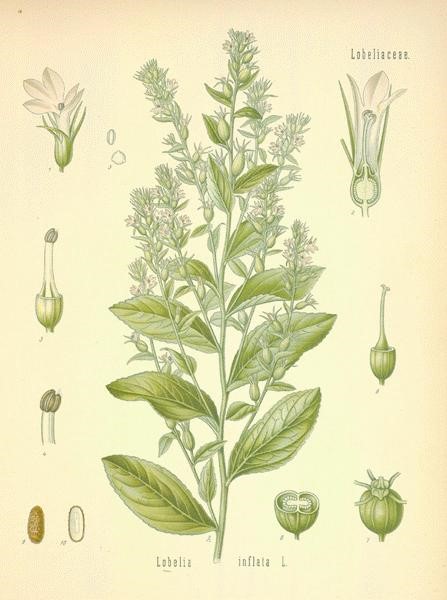
General Plant Information:
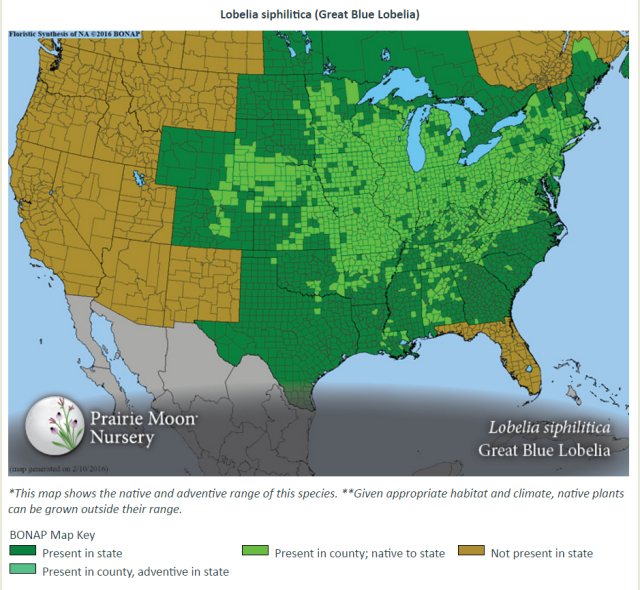
The Great Blue Lobelia, also called Blue Cardinal Flower is native to Eastern North America and grows in full sun to part shade with medium moisture to wet conditions. It is a perennial that blooms from July to October with light blue to bright blue-violet flowers. In Minnesota, the range is shown below:
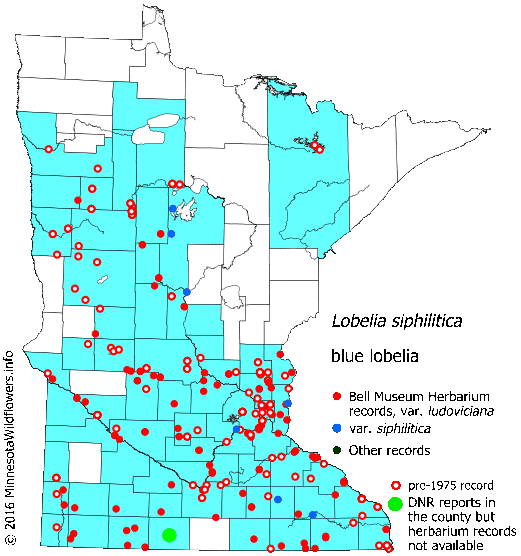
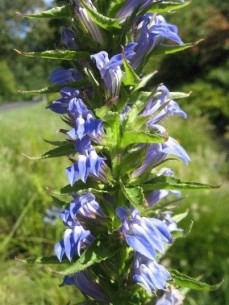 The plant is identifiable through its blue flowers that are 2-lipped with 3 lobes with the lower lip more prominent than the two lobes of the upper lip, making the flower irregular and tubular, with raceme, spike clusters that are typically densely packed at the top and a bit looser towards the bottom, with flowers blooming from the bottom up. The flower has two small bumps near the throat on the lower center lobe with a spot of white at the top of the bumps, with white stripes on the outside of the throat.
The plant is identifiable through its blue flowers that are 2-lipped with 3 lobes with the lower lip more prominent than the two lobes of the upper lip, making the flower irregular and tubular, with raceme, spike clusters that are typically densely packed at the top and a bit looser towards the bottom, with flowers blooming from the bottom up. The flower has two small bumps near the throat on the lower center lobe with a spot of white at the top of the bumps, with white stripes on the outside of the throat.
The leaves are simple, finely-toothed, lance-shaped that can be up to five inches long and two inches wide, with alternate branching. The plant can be between one and four feet when fully grown, with fibrous roots below ground. The plant is a favorite of butterflies that pollinate it, but can also be pollinated by bees and birds.
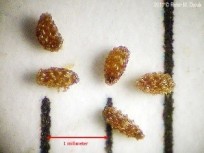 The plant does produce fruit that is a two-chambered capsule with many tiny, oval, semi-translucent golden brown seeds. The seeds are covered in a network of fine ridges and many shiny scale-like appendages that look like shingles.
The plant does produce fruit that is a two-chambered capsule with many tiny, oval, semi-translucent golden brown seeds. The seeds are covered in a network of fine ridges and many shiny scale-like appendages that look like shingles.
Traditional Uses:
The flower received its scientific species name, siphilitica, from its prior usage in the treatment of venereal diseases, mainly syphilis, that was first used by the Iroquois tribe. It has a wide variety of historical usage by some native American tribes that would use it in religious ceremonies and for its medicinal properties. It was used the native American tribes as an infusion to induce vomiting and cure tobacco and whiskey habits or as a love or anti-love medicine. In fact, it was often believed that a finely ground root of Lobelia secretly added to the food of an arguing couple would cause them to love again. A decoction of Lobelia was also taken to counteract sickness produced by witchcraft. The Cherokee mashed the roots of the lobelia, so it could be used as a poultice for body aches.
Europeans first came into contact with the plant through their relationship with Native Americans. Sir William Johnson, superintendent of Indian Affairs in North America, purchased samples of Great Blue Lobelia, known at the time as “the Indian’s secret cure for syphilis,” and sent it to Europe as a syphilis cure. However, European physicians failed to cure the disease with the plant, so it was not accepted as a form of treatment in Europe. This was most likely because Europeans did not use the other herbs typically used in conjunction with the plant to treat syphilis.
Although it was not proven to treat the disease, Swedish botanist Carolus Linnaeus believed the Indian’s characterization and labeled the plant what it is called today “Lobelia Syphilitica”. That was not the only name the plant was called, immigrants to the New World gave it many names mostly in reference to what it could be used for or its Indian uses such as: gag root, vomit wort, asthma weed, and Indian tobacco. The plant was ultimately made famous by a farmer in Alstead, New Hampshire named Samuel Thomson, who was an unorthodox herbal practitioner that used Lobelia along with steam baths as a treatment for his patients. He first came into contact with it as a child and would give it to other kids to watch them vomit for fun. However, Dr. Manasseh Cutler was the first to publish information on the plant’s medicinal properties.
The Chemistry of Great Blue Lobelia:
Lobeline:
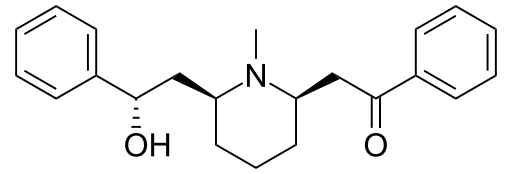
Great Blue Lobelia’s medicinal/toxic properties are due to the presence of alkaloids lobelamine (a precursor of lobeline), lobelanidine, and lobeline. Lobeline is the most important of the alkaloids and is primarily responsible for the plant’s properties. Lobeline acts on the body in a very similar way to nicotine, which acts on nicotinic cholinergic receptors. The alkaloid was first isolated as the main component of Lobelia in 1921 and its stereochemistry was determined in 1965.
Current Medical Uses:
It is not advised to self-medicate with Great Blue Lobelia because an overdose may cause dizziness, nausea, hypotension, vomiting, stupor, tremors, paralysis, convulsions, coma, and even death. Self-medication is also very dangerous because the useful dose of lobeline is very close to the toxic dose and variation among plants can lead to overdose.
Lobelia stimulates the respiratory center of the brain, causing stronger, deeper breaths, making it useful for respiratory problems, like asthma, chronic bronchitis, whooping cough, and pneumonia. While simultaneously relaxing the respiratory and neuro-muscular systems, acting as an antispasmodic. This is due to the presence of lobeline in the plant, which has the highest concentration in the seeds. The whole plant can also be used as an analgesic, cathartic, expectorant, narcotic, stimulant and sedative. Which can treat inflammatory disorders, traumatic injuries, tetanus, sores and abscesses, colds and fevers, diphtheria, and tonsillitis. It also can be used to treat scorpion and snake bites.
Current Research:
Great Blue Lobelia is not commonly studied within the research community, current research that is being done focuses on the plant’s growth patterns shifting in response to climate change, avoiding herbation, and other plant specific studies, very few, if any are being done studying the plant as a treatment option for any diseases.
Lobeline, the chemical derived from the plant is being studied for its medicinal properties:
One studied conducted by Li et al. in 2016 examined lobeline as a way to improve acute lung injury via nuclear factor-kB-signaling pathway and oxidative stress, which found that Lobeline was effective at inhibiting acute lung edema, so it could be used as a possible treatment for all acute lung injury. The study examined lobeline’s ability to reduce NO production and nitric oxide synthase expression by inhibiting the phosphorylation on mitogen-activated protein kinases and IkBa in LPS-stimluated RAW 264.7 cells. Click here for more information: https://www.ncbi.nlm.nih.gov/pubmed/26702732
Another study conducted by Roni MA and Rahman S. in 2015 looked at lobeline as a possible treatment for depression-like behavior in mice. This study used tail suspension tests and forced swim tests and found that lobeline enhanced the effects of reboxetine, fluoxetine, or bupropion in mice. This means that lobeline or similar nicotinic receptor ligands may have therapeutic potential as an adjunct for the treatment of major depression. Click here for more information: https://www.ncbi.nlm.nih.gov/pubmed/26455278
Sources:
https://www.prairiemoon.com/seeds/wildflowers-forbs/lobelia-siphilitica-great-blue-lobelia.html
http://www.missouribotanicalgarden.org/PlantFinder/FullImageDisplay.aspx?documentid=40605
http://www.missouribotanicalgarden.org/PlantFinder/PlantFinderDetails.aspx?kempercode=i460
https://www.minnesotawildflowers.info/flower/blue-lobelia
https://altnature.com/gallery/lobelia.htm
http://www.herballegacy.com/King_History.html
https://www.drugs.com/npp/lobelia.html
Page Created by Carly Johnson
